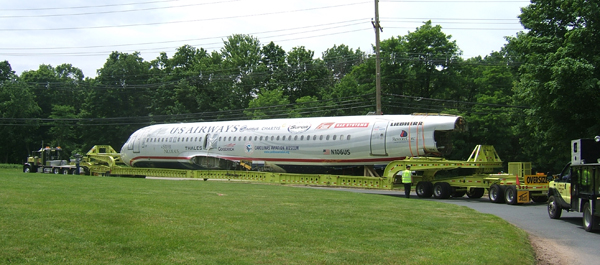
“It is possible that visitors will come away [from the exhibit] thinking that Flight 1549 wasn’t a miracle at all, but a product of 100 years of design change.”
In a press conference the day after US Airways Flight 1549 lost engine power following a bird strike and landed on the Hudson River, NTSB spokesperson Kitty Higgins praised the pilots and crew for their quick thinking under pressure. The Carolinas Aviation Museum in Charlotte—which has acquired the Airbus A320 and is preparing it for exhibition—plans to give Captain Chesley Sullenberger and his crew their due, but, says project manager Shawn Dorsch, the airplane itself will be equally important, including the advanced safety technology that gave the pilots enough time to react. “It is possible that visitors will come away [from the exhibit] thinking that Flight 1549 wasn’t a miracle at all, but a product of 100 years of design change,” he says.
The inspiration for the display came two years ago, when Dorsch saw the Safety Promotion Center at Tokyo International Airport, complete with flowcharts of safety improvements that resulted from the crash of Japan Air Lines Flight 123. These changes included redesigned seats and luggage bins that wouldn’t collapse and prevent people from exiting, features that helped save Flight 1549 passengers. The museum plans to highlight advances made after the Hudson River crash, such as new life vest configurations meant to encourage passengers to don the devices (only a few Flight 1549 passengers took their vests with them before exiting onto the wings), and steps taken to put life vests on 100 percent of airliners.
The “Miracle on the Hudson” A320, partially submerged for several days, is being conserved and reassembled at the museum’s main hangar, though the damaged underbelly and hole in the rear luggage compartment will remain to show how it looked just after impact. The plane will be opened up in certain places to reveal critical safety features, including the racks that held the cockpit voice recorder and flight data recorder, and the auxiliary power unit (APU) that powered the flight controls and flaps after the engines failed.
Plans are for the airliner to be reassembled by January 15, 2012, the third anniversary of the crash, though visitors can watch the work in progress. The fuselage of the A320—the first to be displayed in a museum—arrived on June 10. The fact that the Carolinas Aviation Museum is in Charlotte, the original destination of Flight 1549, helped the staff to acquire the plane in the face of competing bids from the Smithsonian Institution and the Intrepid Sea-Air-Space Museum. For more info, visit carolinasaviation.org.




